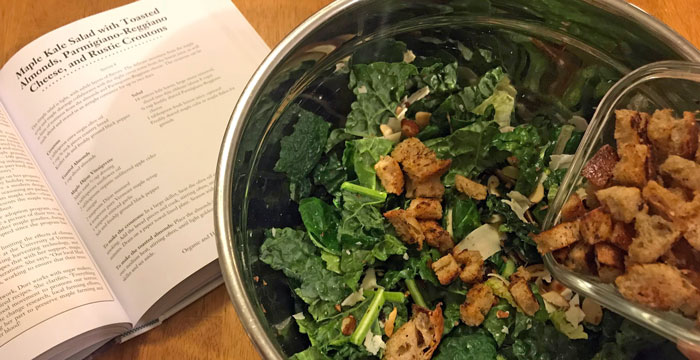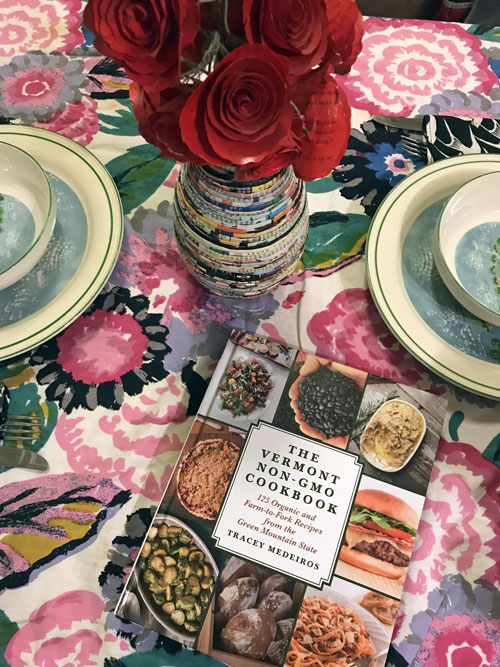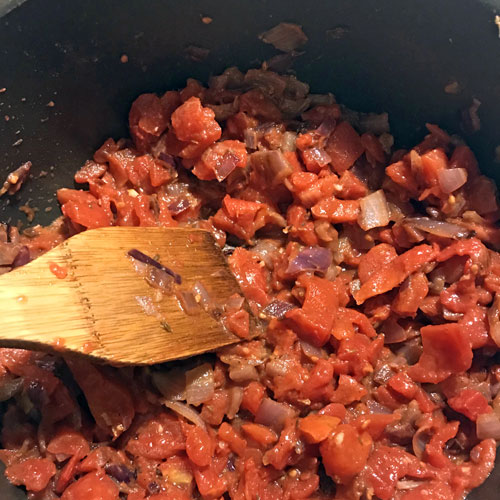
Dining from The Vermont Non-GMO Cookbook & Author Q & A
Spending time in the kitchen can do wonders.
Beyond knowing what’s in your food, preparing a homecooked meal can build trust, intimacy and create bonds.
When I flipped through The Vermont Non-GMO Cookbook, it’s clear that the recipes inside are meant to become experiences. The cookbook is not only filled with colorful photos accompanying the recipes but stories about the farmers, chefs, and providers that are a part of the experience from farm to fork.
To properly assess the cookbook, I tried preparing a few recipes. One evening, I quickly created a lemon and garlic pasta for dinner. The next evening, one of my friends joined to cook a Maple Kale Salad and Coconut Dhal for a more complex meal.
The Maple-Kale salad was fun to put together, beginning from the stovetop crispy croutons. I chose a multigrain sourdough bread to cut and toast, and the flavor was perfection. (Glad I made extra since the sous chef kept sneaking crouton bites!)
The Coconut Dhal was fun to make. To save time, I prepped the lentils earlier in the day and created the rest of the recipe before dinner. The diced tomato base brought a great flavor to the Indian-inspired dish.
The meal was delicious, flavourful and filling. To find out more about the story behind the recipes, I chatted with author Tracey Medeiros about the Vermont creators, non-GMO movement, and the cookbook.
Interview with Tracey Medeiros
(Interview was edited for length and clarity)
The cookbook is full of hearty, seasonal recipes. How did you select them?
The recipes in the book came from the contributors that supported either the organic or non-GMO movements, whether farm producers that are certified organic, non-GMO, or both, or chefs and restaurants that feature organic and non-GMO on their menus.
Each recipe was tested by either myself or a recipe tester that I hired, and we would compare notes and thoughts about the final product.
The cookbook features many profiles of Vermont establishments. What made them stand out?
I was drawn to the folks that are profiled in The Vermont Non-GMO Cookbook because of their universal devotion to their communities and the state. They are concerned about the health of our planet and its inhabitants and are doing all that they can to connect consumers to healthy food, by caring for the soil in which it is grown and believe that it is everyone’s right to know where their food comes from.
How do you think the sustainable food movement is impacting the way people are cooking?
Consumers are becoming more label conscious and want food transparency so that they can make informed decisions. Folks are becoming more aware of the health values of eating clean food.
What do you hope readers will take away from this cookbook?
The Vermont Non-GMO Cookbook simplifies the complexity of the non-GMO movement by offering recipes that include ingredients which do not contain genetically modified organisms. Folks will find ideas for serving healthy, delicious meals using methods that provide alternatives to the foods that we usually eat.
Along with these recipes, the reader will be introduced to the book’s contributors through the use of a profile format. My goal was to put a face on the hardworking folks who took time out of their busy lives to share their stories with me. It was important to me that readers not only savor the book’s delicious recipes but walk in these folks’ shoes for a bit and share their thoughts, dreams and undying passion for what they do.
Why did you choose to make the book theme “Non-GMO”?
My love of farmers’ markets and roadside food stands led to the birth of my first cookbook, Dishing Up Vermont. My second book, The Vermont Farm Table Cookbook, paved the way for my involvement with the non-GMO movement, both of these cookbooks are Vermont-based. During this period, I kept hearing the term non-GMO and meeting more and more farmers, farms and food producers who practiced this philosophy. This led me to want to learn more about the view and workings of the non-GMO movement.
The fall of 2017 saw the release of my fourth book, The Vermont Non-GMO Cookbook. Vermont became the first U.S. state to pass the historic GMO Food Labeling law, forever changing the way Americans eat. Even though Vermont’s historic GMO Food Labeling law was nullified, these hardworking folks forge on, working to educate consumers on the importance of “Knowing What is in Your Food!”
I am also the co-author of The Connecticut Farm Table Cookbook. Each of my books seemed to open the door for the next.
To learn more about Tracey, visit www.traceymedeiros.com.












